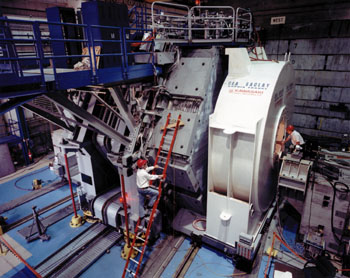Experimental results reveal an unprecedented difference between matter and antimatter

Particle physicists from England and various parts of the world from the BABAR experiment at the Stanford Linear Accelerator Center (SLAC) in the United States announced on August 2 exciting new results that illustrate a significant difference between the behavior of matter and antimatter. Their discovery may help explain the fact that our universe contains mostly matter and does not consist of equal amounts of matter and antimatter.
SLAC's PEP 2 accelerator collides electrons and their antiparticles, positrons. The collision of the particles and antiparticles creates a shower of heavy and exotic particle pairs, known as B mesons and anti-B mesons. These rare particles live for a very short time and quickly decay into other subatomic particles that are lighter than them, such as kaons and pions, which can be discovered in the BABAR experiment.
"If there was no difference between matter and antimatter, their B-particles and antiparticles would decay in exactly the same way. However, our new measurements show an example of a large difference in the decay rates between the B-nutrients and anti-B-nutrients," said BABAR experiment spokesperson Marcelo Giorgi of SLAC, University of Pisa and INFN.
By examining the decays of over 200 million pairs of B and anti-B substances, the researchers discovered an amazing asymmetry between matter and antimatter. "We found 910 cases in which food B broke down into kaon and pion, but only 696 cases in which the anti-food B did," Giorgi explained. "The new measurements are definitely the result of the outstanding operation of SLAC's PEP 2 accelerator and the great efficiency of the BABAR detector. The accelerator now operates three times more efficiently than its original design, and the BABAR detector manages to record about 98% of the collisions between the particles."
Although BABAR and other experiments have previously detected asymmetries between matter and antimatter, this is the first time such a difference has been detected by simply counting the number of decays of B-matter and B-antimatter to the same final state. This effect is known as "direct CP violation" (Charge Parity Violation Direct), and it was detected at a rate of 13%. A similar effect occurs in the decays of kaons and anti-kaons, but at a rate of only 4 parts per million!
"This is a strong and convincing sign of direct CP violation in B decays, a type of asymmetry between matter and antimatter, predicted theoretically but not observed experimentally so far. With the help of this discovery the full pattern of the asymmetries between matter and antimatter begins to become clear and coalesce into a complete picture. I am very excited and pleased that one of my postdoctoral students, Carlos Chavez, who now works at SLAC, was directly involved in the discovery,” said Christos Touramanis of the University of Liverpool.
Dan Bowerman, a member of the BABAR team from Imperial College, adds: "When the universe began with the Big Bang, matter and antimatter were created in equal amounts. However, all observations indicate that we live in a world of matter. If so, we ask, what happened to antimatter? The work at BABAR brings us closer to the answer to this question."
Tiny differences between the behavior of matter and antimatter are surely responsible for the imbalance between matter and antimatter that has developed in our universe. However, our current knowledge of these differences is incomplete and insufficient to account for the material's apparent superiority. The phenomenon of CP violation is one of the three conditions that the Russian physicist Andrei Sakharov described as the reason for the apparent imbalance between matter and antimatter in our universe.
Professor Ian Halliday, director of the Particle Physics and Astronomy Research Council, which is funding the English team's participation in the BABAR experiment, said: "We still do not fully understand how the universe of matter in which we live developed. However, the new findings aided by additional measurements at BABAR and other experiments around the world have significantly advanced our understanding of the subject. There is still a lot to learn and discover in this fundamental field."
translating:
Dikla Oren
Learn more:
What is a CP violation?
The scientific article on the results of the experiment
Press release of the Particle Physics and Astronomy Research Council
